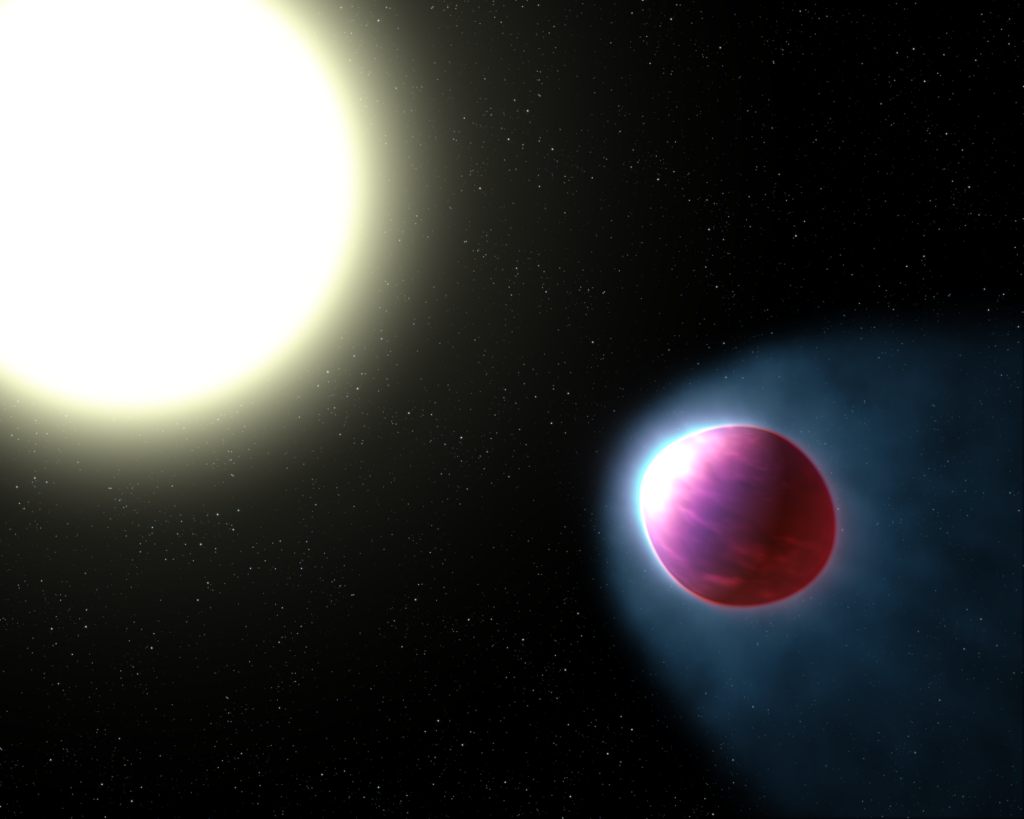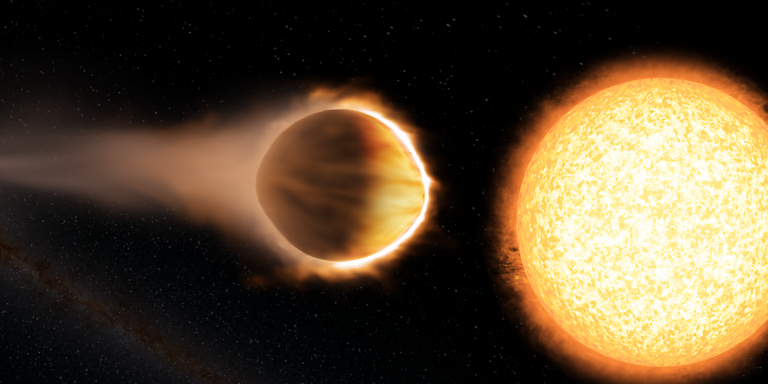Hubble Spots Exoplanet Featuring a Radiant Atmosphere of Water
A team of international researchers, led by the University of Exeter, has made a groundbreaking discovery regarding an exoplanet outside our solar system. Using NASA’s Hubble Space Telescope, they have found compelling evidence of a stratosphere on this massive planet, accompanied by an incredibly hot atmosphere capable of boiling iron.To investigate the gas giant’s stratosphere, which is a layer of the atmosphere where temperature rises with increasing altitude, scientists employed spectroscopy. This technique allowed them to analyze how the planet’s brightness changed at various wavelengths of light.
Water vapor within the exoplanet’s atmosphere exhibits distinct behavior in response to different wavelengths of light, depending on its temperature. At lower temperatures, water vapor in the upper atmosphere obstructs specific wavelengths of light emitted from deeper layers and heading towards space. However, at higher temperatures, the water molecules in the upper atmosphere emit light at these wavelengths instead, resulting in a glowing effect.This phenomenon is akin to the way fireworks produce vibrant colors through the emission of light by certain chemicals. When metallic substances are heated and vaporized, their electrons transition to higher energy states. As these electrons lose energy, they emit light at specific wavelengths, such as sodium producing orange-yellow and strontium producing red.
Similarly, the water molecules in the atmosphere of the exoplanet WASP-121b emit radiation as they lose energy. However, this radiation takes the form of infrared light, which is beyond the detection capabilities of the human eye.
Dr Tom Evans, a research fellow at the University of Exeter, stated that stratospheres may have a unique classification among ultra-hot exoplanets, which has significant implications for atmospheric physics and chemistry. When the Hubble telescope was directed towards WASP-121b, it detected luminous water molecules, indicating the presence of a robust stratosphere.WASP-121b, commonly known as a ‘hot Jupiter’, is a gas giant exoplanet situated approximately 900 light years away from Earth. Despite being larger and more massive than Jupiter, it possesses a greater volume, resulting in a more inflated appearance. This exoplanet completes an orbit around its host star every 1.3 days, maintaining an incredibly close distance that is just before the point where the star’s gravitational forces would tear it apart.
Due to this close proximity, the uppermost layer of the atmosphere experiences scorching temperatures of 2,500 degrees Celsius, causing iron to exist in a gaseous state rather than as a solid.

The temperature in the stratosphere of WASP-121b experiences a significant increase, although the exact cause of this intense heating is still unknown, according to Nikolay Nikolov, a research fellow at the University of Exeter. To unravel this mystery, further observations at different wavelengths are planned.
Vanadium oxide and titanium oxide gases are potential heat sources, as they have a strong ability to absorb starlight at visible wavelengths, similar to how ozone absorbs UV radiation. These compounds are expected to exist only in the hottest of hot Jupiters, like WASP-121b, as they require high temperatures to remain in a gaseous state.Interestingly, vanadium oxide and titanium oxide are commonly found in brown dwarfs, which are “failed stars” that share some similarities with exoplanets.
Previous research conducted over the past decade has suggested the presence of stratospheres on other exoplanets. However, the recent detection of glowing water molecules provides the clearest evidence yet for the existence of an exoplanet stratosphere.
An international team of scientists, led by Associate Professor David Sing at the University of Exeter and Dr. Mercedes Lopez-Mórales at the Smithsonian Institution, has achieved a significant breakthrough in their new observing program. This program, which has been granted 800 hours of study time, aims to investigate and compare 20 different exoplanets. This allocation of time is one of the largest in the entire 27-year history of the Hubble telescope.
According to Professor David Sing, co-author and Associate Professor of Astrophysics at the University of Exeter, this research provides compelling evidence that scientists have long been searching for when studying hot exoplanets. The discovery of a stratosphere in this hot Jupiter is particularly noteworthy, as it is a common feature observed in most planets within our solar system.
This finding is truly remarkable as it reveals significant variations from one planet to another. These differences offer valuable insights into the behavior of planets under diverse conditions. However, it is important to note that this is just the beginning, as the team has only scratched the surface of the vast amount of new data collected by the Hubble telescope.Looking ahead, NASA’s upcoming James Webb Space Telescope holds great promise in further exploring the atmospheres of planets like WASP-121b. With its enhanced sensitivity, it will surpass any existing telescope currently in space.Hannah Wakeford, co-author and Research Fellow at the University of Exeter, emphasizes the significance of this super-hot exoplanet as a benchmark for atmospheric models. Moving into the Webb era, it will serve as an excellent target for future observations.
Overall, this research marks a significant milestone in our understanding of exoplanets and sets the stage for further advancements in the field.
This article is republished from PhysORG under a Creative Commons license. Read the original article.
Do not forget to share your opinion with us to provide you with the best posts !




0 Comments